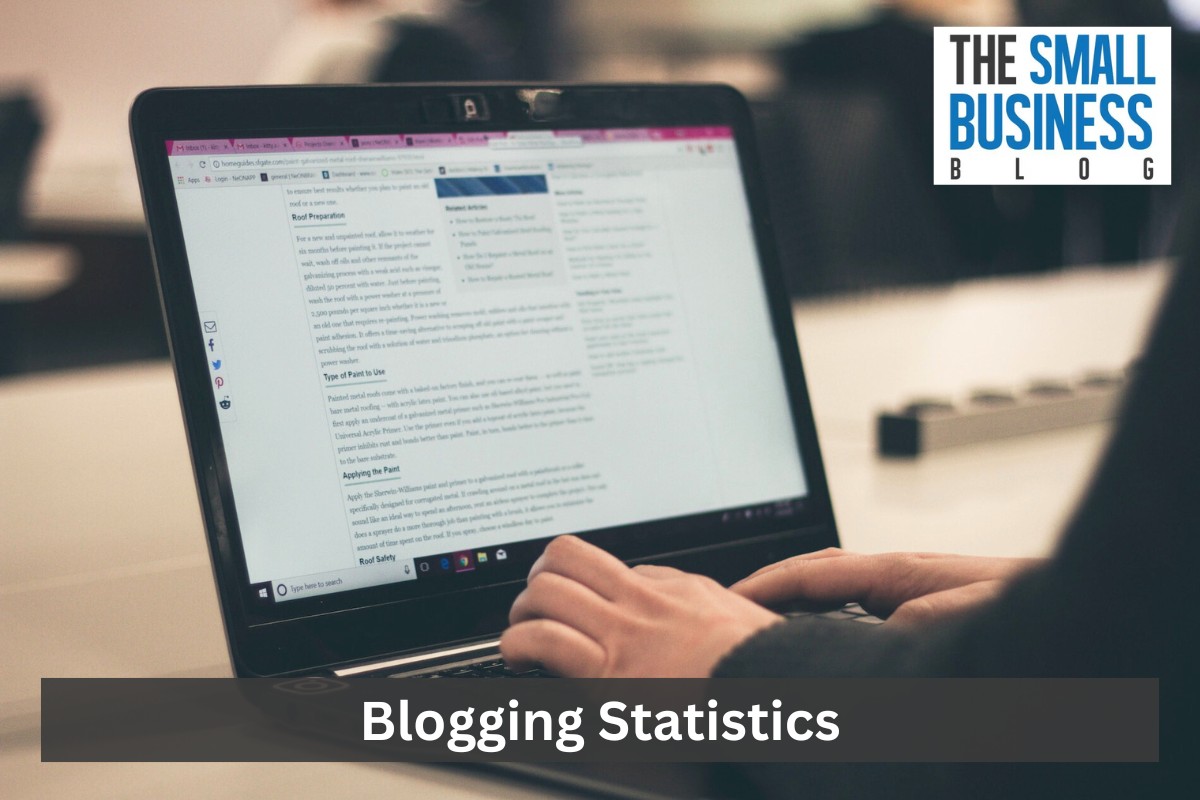Blogging has emerged as a dynamic and influential medium of expression, sharing knowledge, fostering connection, and communication.
It offers a platform to share insights, experiences, and passion.
Entrepreneurs, freelancers, and professionals across industries can use blogs to showcase their expertise to a global audience.
Blogs come in various forms, catering to diverse niches and interests.
Within the realm of blogs, there are personal blogs that share experiences, thoughts, and daily life.
Moreover, niches like food, lifestyle, fashion, finance and money, fitness and health, parenting, technologies, DIY and crafts, politics, books, and games find their voices through blogs.
Blogging statistics provide valuable insights into the performance and impact of blogs.
Understanding these statistics is crucial for bloggers, content creators, marketers, and businesses.
It enables them to understand audience preferences, identify trends, measure engagement, and track traffic growth.
Do you want to discover captivating insights about the world of blogging and some blogging statistics?
Just continue reading.
Post Contents
- 1 Top Blogging Statistics in 2024
- 1.1 1. There are Approximately 600 Million Blogs Over the Internet
- 1.2 2. More Than 8 Million Blog Posts Are Published Daily
- 1.3 3. US Internet Users Who Read Blogs on a Computer Were Aged Between 30 and 49 Years Old
- 1.4 4. Internet Users Search “How to Start a Blog” on Google for Around 53,000 Times Each Month
- 1.5 5. 22% of Bloggers Publish Blog Posts and Content Weekly
- 1.6 6. Roughly 409 Million Internet Users View Blogs From Over 21 Billion Pages Monthly
- 1.7 7. Companies and Businesses with Blogs Produce More Leads at an Average of 67% Monthly
- 1.8 8. “How-To-Articles” Were the Most Popular Format for Blog Content in 2019
- 1.9 9. More Than Nine out of Ten Content Marketers Create Blog Posts
- 1.10 10. About 70 Million New Blog Posts and 77 Million New Comments Monthly are in WordPress
- 1.11 11. 32% of Bloggers Always Access and Check Traffic Analytics
- 1.12 12. Blog Contents With Over 2,000 Words are More Likely to Produce Higher Search Rankings
- 1.13 13. More Than Half of All Bloggers Are 21 to 35 Years Old
- 1.14 14. The Estimated Bloggers Count in the United States Exceeded 31 Million in 2020
- 1.15 15. Food and Personal Finance Blogs are the Highest-Earning Blog Niches
- 1.16 16. The Top Three Blogging Niches With Most Traffic Are Food, Lifestyle, and Travel
- 1.17 17. Almost 26% of Young People Aged 5-18 Read Blogs in the United Kingdom
- 1.18 18. Blog Content with a 7-Minute Read Attracts the Most Readers’ Attention
- 1.19 19. Blogs with Images Gather More Traffic Than Blogs with Text Alone
- 1.20 20. Bloggers Write a Blog Post for Around 4 Hours
- 1.21 21. Nearly 37% of Bloggers Start a Blog with Over $100 Budget
- 1.22 22. Average Bloggers Can Make up to $1,000 Monthly
- 2 Conclusion
Key Statistics
- Around 600 million blogs exist across the internet.
- Companies and businesses that maintain active blogs witness a substantial rise of around 67% in monthly lead generation.
- About 409 million internet users actively interact with blog content, contributing to 21.1 billion pages viewed.
- Blog posts with a word count of around 2,000 produce a higher search ranking and optimal impact.
- Blogs with a 7-minute read content garner the highest attention from online audiences.
- Blogs centered on Food and Personal Finance emerge as the top-earning niches, with a median monthly income surpassing $9,000.
- Average bloggers can generate monthly earnings of up to $1,000.
Top Blogging Statistics in 2024

1. There are Approximately 600 Million Blogs Over the Internet
Blogging has transformed how people learn in the digital age.
It became a valuable source of information and expertise.
It is like a creative canvas where writers can express their knowledge and ideas using text and images.
Similarly, blogging has become part of many businesses’ online marketing strategies.
Brands use blogs to show their products or services and engage with wider audiences.
Whether for personal expression or professional growth, blogging remains a powerful and versatile tool in the modern world.
According to the latest blogging statistics, the number of blogs exceeds 600 million in 2023 out of over 1.9 billion websites.
This count started from only 23 blogs in 2000 until it reached 150 million after a decade.
Here are the numbers of blogs from 2000 to 2023:
- The number of blogs over the internet in 2000 was around 23 blogs
- The number of blogs over the internet in 2006 was around 50 million blogs
- The number of blogs over the internet in 2010 was around 152 million blogs
- The number of blogs over the internet in 2023 was around 600 million blogs
(Oberlo, GrowthBadger, Techjury)
2. More Than 8 Million Blog Posts Are Published Daily
On a global scale, blogging has led to an overwhelming production, with more than 3 billion published blog posts annually.
This substantial number underscores the impact and influence of this digital medium.
The figure is equivalent to an average of 8.28 million blog posts daily, or around 5,750 blog posts per minute.
The surge of blog posts highlights the immense diversity of topics and viewpoints over the internet.
It signifies a continuous flow of information, ideas, and insights, enriching the digital landscape and contributing to human knowledge.
(GrowthBadger)
3. US Internet Users Who Read Blogs on a Computer Were Aged Between 30 and 49 Years Old
Blog posts can be accessed through computers, tablets, and smartphones.
In 2022, the age group of internet users in the United States that primarily engaged with blogs on computers was from 30 to 49 years old, accounting for 26%.
Below are the percentages of internet users in the US who read blogs on computers in 2022:
- 21% of US internet users aged 18-29 read blogs on computers in 2022
- 26% of US internet users aged 30-49 read blogs on computers in 2022
- 17% of US internet users aged 50-64 read blogs on computers in 2022
(Statista)
4. Internet Users Search “How to Start a Blog” on Google for Around 53,000 Times Each Month
Numerous people interested in blogging ask “How to start a blog” on Google Search.
According to search analytics data, this search term garners around 53,000 monthly searches on Google alone.
This significant search volume highlights the curiosity and eagerness of people to partake in the realm of blogging.
To translate this, about 1,700 individuals actively explore the possibility of embarking on a blogging journey.
(GrowthBadger)
5. 22% of Bloggers Publish Blog Posts and Content Weekly
Are you thinking of how frequently bloggers worldwide post blogs?
A survey reveals that 22% of bloggers published blog posts and content weekly in 2021.
Interestingly, only 2% of the surveyed bloggers post blogs daily.
This data shows that weekly publishing allows bloggers and writers to conduct thorough research and refine their posts before publishing.
On the other hand, the small percentage of bloggers who commit to daily publication shows dedication and commitment to providing fresh content to their audiences.
Let’s take a look at the posting frequency of blogs in 2021:
- 1% of surveyed bloggers worldwide post blogs “more than daily.”
- 2% of surveyed bloggers worldwide post blogs “daily.”
- 13% of surveyed bloggers worldwide post “2-6 blogs per week.”
- 22% of surveyed bloggers worldwide post blogs “weekly.”
- 23% of surveyed bloggers worldwide post blogs “several times per month.”
- 16% of surveyed bloggers worldwide post blogs “monthly.”
- 7% of surveyed bloggers worldwide post blogs “less than monthly.”
- 16% of surveyed bloggers worldwide post blogs “with irregular intervals.”
(Statista)
6. Roughly 409 Million Internet Users View Blogs From Over 21 Billion Pages Monthly
Every month, over 409 million internet users actively engage with online content.
These people contribute to more than 21.1 billion pages viewed.
This figure underscores readers’ interest in information, entertainment, and interaction within the digital world.
With every page viewed, knowledge is acquired, stories are shared, and connections are made.
This highlights the impact of digital content in informing, inspiring, and captivating global audiences.
(FinancesOnline)
7. Companies and Businesses with Blogs Produce More Leads at an Average of 67% Monthly
Blogs hold a remarkable influence on businesses.
Companies equipped with active blogs experience a significant increase of approximately 67% in monthly lead generation compared to their counterparts that do not engage in blogging.
Among B2B marketers, about 59% consider blogs the most crucial channel for their marketing strategies.
Blogs also wield a substantial impact on search engine optimization (SEO), contributing to an extensive rise of 434% in indexed pages and 97% in indexed links.
These percentages show that blogs are integral tools that drive lead generation, foster marketing strategies, and enhance online visibility.
(DemandMetric, Hubspot)
8. “How-To-Articles” Were the Most Popular Format for Blog Content in 2019
Based on the 2019 survey, “how-to-articles” were the most popular formats for blog content worldwide.
About 77% affirmed their involvement in publishing “how-to-articles” within the year.
“News and trend articles” come next, with 49% of surveyed bloggers posting this format.
Here are the most popular formats for blog content in 2019:
- 77% of bloggers have published “how-to-articles” in 2019
- 49% of bloggers have published “news and trend articles” in 2019
- 47% of bloggers have published “guides and e-books” in 2019
- 44% of bloggers have published “opinion articles” in 2019
- 41% of bloggers have published “interview articles” in 2019
- 35% of bloggers have published “original research” in 2019
- 30% of bloggers have published “infographics” in 2019
(Statista)
9. More Than Nine out of Ten Content Marketers Create Blog Posts
Blog posts are the most favored content format within the domain of content marketers.
Over nine out of ten content marketers, equivalent to 92%, engage in blog post creation as an integral component of their marketing strategies.
In contrast, the use of emails and infographics is embraced by a comparatively lower portion of content marketers, standing at 66% and 45%, respectively.
A study found that businesses that publish a blog witness a 55% increase in website visitors compared to those who do not have blogs.
(Oberlo)
10. About 70 Million New Blog Posts and 77 Million New Comments Monthly are in WordPress
WordPress serves as a go-to blogging platform for content creation and engagement.
Approximately 70 million new blog posts take shape monthly, and 77 million new comments contribute to the dynamic engagement between content creators and readers.
This dynamic environment reflects the boundless creativity and global connectivity that characterize the online world.
(WordPress)
11. 32% of Bloggers Always Access and Check Traffic Analytics

A 2019 survey revealed that 32% of bloggers worldwide always accessed and checked their blog post analytics.
This practice shows bloggers’ dedication to assessing their online content’s performance, refining their strategies based on data insights, enhancing user experiences, and audience engagement.
Let’s see how often bloggers check traffic analytics in 2019:
- 4% of the respondents don’t have access to analytics
- 12% of the respondents never or rarely check traffic analytics
- 26% of the respondents occasionally check traffic analytics
- 26% of the respondents usually check traffic analytics
- 32% of the respondents always check traffic analytics
(Statista)
12. Blog Contents With Over 2,000 Words are More Likely to Produce Higher Search Rankings
Blogging experts recommend publishing blog posts ranging from 1,760 to 2,400 words for optimal impact.
The general rule is that more detailed blogs lead to higher quality.
Longer posts offer better keyword coverage, comprehensiveness, traffic attraction, SEO improvement, and overall better outcomes.
Particularly for Google rankings, longer content is preferred due to its algorithm.
It is important to note that Google’s ranking considers factors beyond word count.
Data and studies indicate that longer blog posts, ideally exceeding 1,000 words, tend to perform better for SEO, and posts should at least aim for 300 words to avoid being categorized as thin content.
(SWEOR, OptinMonster, HookAgency)
13. More Than Half of All Bloggers Are 21 to 35 Years Old
The blogging industry is not dominated by younger individuals.
There is a diverse distribution of ages within the blogger community.
Bloggers aged 20 years and below and 36 to 50 years old constitute around 40% of the overall bloggers’ population.
More than half of all bloggers are between 21 to 35 years old.
Below is the age distribution of bloggers:
- 20.2% of bloggers are 20 years old and younger
- 53.3% of bloggers are between 21 to 35 years old
- 19.4% of bloggers are between 36 to 50 years old
- 7.1% of bloggers are 51 years old and above
(FinancesOnline)
14. The Estimated Bloggers Count in the United States Exceeded 31 Million in 2020
Blogging is popular in the United States.
In 2014, approximately 27.4 million internet users engaged in monthly blog updates.
After eight years, the projected count of bloggers in the country is expected to reach 32.7 million, up from 31.7 million in 2020.
Here is the list of the estimated bloggers count in the United States from 2014 to 2022:
- In 2014, the estimated US bloggers count was 27.4 million
- In 2016, the estimated US bloggers count was 29.1 million
- In 2018, the estimated US bloggers count was 30.6 million
- In 2020, the estimated US bloggers count was 31.7 million
- In 2022, the estimated US bloggers count was 32.7 million
(Statista, Techjury)
15. Food and Personal Finance Blogs are the Highest-Earning Blog Niches
People create blogs for different reasons, including self-expression, passion, personal branding, advocacy, and income generation.
These motivations are diverse, reflecting the potential of blogging for personal, professional, and social purposes.
A common curiosity lies in understanding bloggers’ earnings.
Recognizing the most lucrative blogging niches can significantly impact income.
Notably, Food and Personal Finance blogs emerge as the highest-earning blog niches, with a median monthly income exceeding $9,000.
Here are the four highest-earning blog niches:
- Food Blogs – with a median monthly income of $9,169
- Personal Finance Blogs – with a median monthly income of $9,100
- Lifestyle/Mommy Blogs – with a median monthly income of $5,174
- Travel Blogs – with a median monthly income of $5,000
(RankIQ)
16. The Top Three Blogging Niches With Most Traffic Are Food, Lifestyle, and Travel
Focusing on a niche helps bloggers attract a particular audience interested in a specific topic, enabling them to establish themselves as experts or enthusiasts in that field.
According to a study, food, lifestyle, and travel are the top blogging niches with the most traffic.
Nearly 43% of blogs with over 50,000 sessions monthly are food blogs.
Below are some of the niches with the most traffic:
- Food blog niche – accounted for 42.8% of high-traffic blogs
- Lifestyle blog niche – accounted for 13.3% of high-traffic blogs
- Travel blog niche – accounted for 10% of high-traffic blogs
- Arts/Crafts blog niche – accounted for 8% of high-traffic blogs
- Outdoors blog niche – accounted for 5% of high-traffic blogs
(RankIQ)
17. Almost 26% of Young People Aged 5-18 Read Blogs in the United Kingdom
In 2022, about 25.7% of young people aged five to 18 in the United Kingdom engaged in reading blogs.
This percentage marks a growth of around 10% compared to the data observed in 2010.
The year 2021, in particular, witnessed a notable surge in the popularity of reading blogs among children in the UK, accounting for 27.8%.
The following are the shares of young people reading blogs in the UK from 2010 to 2022:
- 16.1% of young people read blogs in the UK in 2010
- 18.9% of young people read blogs in the UK in 2013
- 17.3% of young people read blogs in the UK in 2016
- 27.4% of young people read blogs in the UK in 2019
- 25.7% of young people read blogs in the UK in 2022
(Statista)
18. Blog Content with a 7-Minute Read Attracts the Most Readers’ Attention
Blog content with a 7-minute read duration captures the highest attention from online audiences.
To illustrate, considering an average adult who regularly engages with blogs, their reading pace averages around 265 words per minute.
Using this guideline, a blog post optimized for a 7-minute read would ideally encompass roughly 1,850 words.
In terms of reading behavior, readers allotted only 37 seconds to scan through a blog post.
Approximately 43% of readers prefer to skim content rather than thorough reading.
A noticeable gap exists between the time invested by bloggers in crafting posts and the relatively concise timeframe that typical blog visitors allot to reading.
This data emphasizes the challenges bloggers face in capturing and retaining the interest of their target audience within a digital landscape marked by swift information consumption.
(Techjury)
19. Blogs with Images Gather More Traffic Than Blogs with Text Alone
Blog posts with images gather more traffic than those relying solely on text.
The human brain naturally processes visuals faster and more efficiently than textual content.
The 2022 statistics highlight that visual content boasts a retention rate of 65%, far surpassing the 10% to 20% range observed for text alone.
Similarly, integrating relevant images enhances readers’ comprehension of the blog posts.
Moreover, the inclusion of images carries additional advantages.
It contributes to enhanced visibility on search engines and increased social media engagement.
It shows that integrating images elevates content quality, accessibility, and effectiveness.
(Techjury)
20. Bloggers Write a Blog Post for Around 4 Hours
The time dedicated to creating blog posts has been increasing over the years.
In 2014, bloggers allotted around 2 hours and 24 minutes to compose a blog post, which grew to 4 hours and 10 minutes in 2022.
This trend reflects the importance of producing high-quality content in line with search engine criteria.
As search engines prioritize quality, bloggers dedicate more time to ensure their blog content meets these standards and delivers value to their audience.
Let’s find out how long bloggers take to write blog posts:
- In 2014, bloggers wrote a blog post for 2 hours and 24 minutes
- In 2016, bloggers wrote a blog post for 3 hours and 16 minutes
- In 2018, bloggers wrote a blog post for 3 hours and 28 minutes
- In 2020, bloggers wrote a blog post for 3 hours and 55 minutes
- In 2022, bloggers wrote a blog post for 4 hours and 10 minutes
(OrbitMedia)
21. Nearly 37% of Bloggers Start a Blog with Over $100 Budget
According to a survey, roughly 36.8% invested over $100 when starting their blog, while 33.4% commenced with a budget ranging from $20 to $100.
Meanwhile, 12.9% aimed for a positive blogging return on investment (ROI) with an expenditure of $20 or less.
On the other hand, 16.9% chose not to allocate any funds to their blog venture.
(Techjury)
22. Average Bloggers Can Make up to $1,000 Monthly

One common question in the blogging world revolves around the potential for bloggers to establish a reliable source of income.
A 2012 survey highlighted that 81% of bloggers earned less than $100 annually, while only 8% attained family-sustaining incomes.
More recent findings from 2022 indicate that the average blogger earns up to $1,000 monthly.
Other studies showed that 23.1% of bloggers earn up to $200 monthly, with just 12.8% earning $1,000 to $2,500.
The spectrum of blogging income spans from minimal to substantial, revealing the diverse financial outcomes within the blogging community.
(Techjury)
Conclusion
Blogging has transformed into a versatile medium for information sharing and content creation.
It enables individuals, businesses, and organizations to express themselves, showcase expertise, engage with audiences, and generate income.
Blogging statistics play a significant role in understanding the dynamics of this ever-evolving landscape.
These statistics offer insightful information about audience behavior, content preferences, trends, engagement patterns, and the impact of blogging on different industries.
By analyzing these data, bloggers can make informed decisions to optimize their strategies, create more engaging content, and effectively reach their target audiences.
From the explosive growth in the number of blogs to the impact of visual content, reading habits, and earning potential, blogging statistics shed light on the evolving trends within the digital world.






























